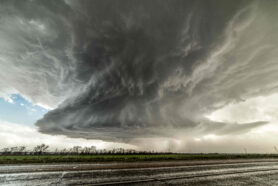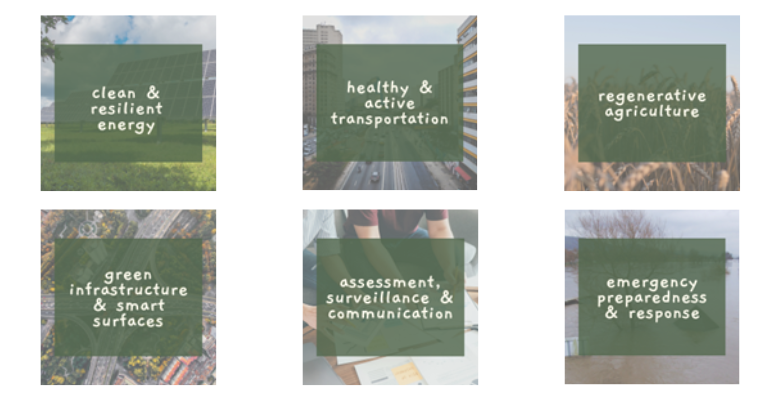Bringing Climate Back into Focus in 2023
- By: Ajay Persuad and Madelyn Gustafson
- Date
When reflecting on the year 2022, challenges like the ongoing COVID-19 pandemic to the war in Ukraine and global economic uncertainty might have popped into your head.
Although 2022 was a bumpy road, to say the least, there is one thing that has continued to persist for many communities around the country: climate change. From droughts to flooding to wildfires, natural disasters have impacted communities coast to coast, putting a strain on both the capacity and resources needed.
Climate & Weather in 2022
A recent statement by Vice President Kamala Harris best summarizes the challenges we currently face:
“Last year, our nation experienced a total of 20 climate-driven extreme weather events, which caused — each caused more than $1 billion in damage — each one — and, more importantly, resulted in the death of about 700 people. . . and the takeaway is clear: as the climate crisis gets worse, extreme weather will pose a rapidly growing danger to a rapidly growing number of communities.” – Kamala Harris, “Remarks by Vice President Harris on Climate Resilience,” Florida International University, Miami Florida, 2022.1
Compounding on other domestic challenges such as the COVID-19 pandemic and racial injustice, climate change has negatively impacted Americans’ health in the following ways over the course of 2022:
Air pollution: Over 40% (>137 million people) live in cities where air pollution levels exceed U.S. regulatory standards.2 Also contributing to worsening air quality are longer, more severe allergy seasons, caused by rising temperatures which in turn results in more pollen and other allergens in the air, resulting in an increase prevalence of asthma attacks.3
Heat exposures: 2022 saw recording breaking heatwaves from coast to coast between May and September.4 Approximately 136 people died as a result of the 2022 heat waves, in which dozens of heat records were surpassed. Moreover, these events cost an estimated 22.2 billion dollars in damages as per NOAA’s assessment.5 Everyone is vulnerable when it comes to heat exposure, from children to the elderly, so it is important to ensure that community-level strategies are implemented when record heat occurs.
Infectious disease: Evidence has suggested that climate change may be linked to approximately 60% of all new cases of infectious diseases globally. Changes in temperature and precipitation can alter animal migration and potential vectors such as mosquitoes and ticks, which can lead to changes in the prevalence of vector-borne and zoonotic diseases such as dengue fever, Zika virus, Lyme disease, Ebola, and avian flu. For example, in 2022 alone, there were 79 deaths associated with West Nile Virus and the incidence of Lyme disease in the U.S. has nearly doubled (7.21 reported cases per 100,000) since 1991.6,7 In fact, CDC estimates that 476,000 people are diagnosed or treated annually in the U.S.8
Extreme storms and disasters: 2022 had devastating emergency disasters, from Hurricane Ian in Florida to the ongoing wildfires throughout the West. The emotional and economic impacts of these disasters are far greater than anyone would imagine. The economic burden of Hurricane Ian to Southwest Florida and beyond could exceed more than $120 billion with over 140 fatalities, which is just one of twenty, billion dollars plus, extreme weather incidents that occurred in 2022.5
Mental health impacts: Communities faced with an increase in extreme weather events, economic losses, and ties to the land all face an increased risk of mental health issues such as depression, stress, PTSD, and grief. Adults and children alike who live in agricultural or rural areas, along with indigenous and minority communities face an even higher susceptibility to negative mental health impacts because of climate change.9
Climate Action in 2022
In recognition of the devastating impact that climate change poses on the health of the American people, in 2022, the U.S. Congress voted into law several important pieces of legislation, including the Inflation Reduction Act & the Infrastructure Investment and Jobs Act. These initiatives will finance climate improvements, by investing in meaningful efforts to address climate threats and transition the U.S. away from fossil fuels and towards green energy sources.
In addition to the actions taken by Congress in 2022, January 27th, 2023, marked the second-year anniversary of President Joe Biden’s Executive Order on Tackling the Climate Crisis at Home and Abroad. The executive order highlights several actions that continue to apply to how we can and will move forward in 2023; centering climate in policy and national security, an all-government agency approach, and empowering workforces to rebuild sustainable infrastructure, conservation, and reforestation. Through the executive order, the National Climate Task Force was developed to coordinate federal action on climate change and direct federal agencies to take immediate action to reduce greenhouse gas emissions. It also called for the development of a comprehensive, government-wide strategy to address the climate crisis, with a focus on environmental justice and job creation.10
Although this work has signaled a commitment to addressing climate change, the United States is still a long way from successfully pursuing strategies that factor in health and racial equity goals. Overall, the Executive Order on Tackling the Climate Crisis at Home and Abroad signals a major shift in US climate policy and sets the country on a path to confront the climate crisis with urgency and ambition. 2023 offers opportunities to learn, explore, ask questions and be curious about your impact on climate and how the public health workforce can act on climate and environmental justice.
Looking Forward to 2023
As we look forward to 2023, public health professionals can make the commitment to not only help their communities address the health impacts of climate change, but also adopt climate resilient policies and practices.
Such examples of these practices may include:
Public health professionals can jump start their efforts by taking part in the Climate Ambassador Training conducted by NNPHI and ecoAmerica. This training is focused on developing climate solutions, the importance of climate communication and building confidence to advocate and speak on climate in your local community.11
In addition to the training, review and use the Climate Change, Health and Equity: A Guide for Local Health Departments from American Public Health Association and the Public Health Institutes.12 This guide is a deep dive into what local health departments can do in climate action and beyond. To avoid devastating extreme weather events and support a livable environment, it is critical that the U.S. move towards eco-friendly forms of agricultural development, transportation and energy and public health is a piece of that puzzle.
The last year has brought devastating climate events and hopeful climate legislative action. However, to change the course of climate change, we must incorporate climate resiliency and justice into public and environmental health practices, preparedness, response, and recovery to ensure a more equitable and healthier future for all individuals. One such example of this can be seen through Acclimate Colorado – an initiative from the Colorado Public Health Institute.13 By providing the local and state governments with a framework and policy agenda to both assess the physical and mental health risks of the communities facing the impacts of climate change, this program will lay the foundation for climate adaptation within the state.
References
1 The United States Government. (2022, August 1). Remarks by Vice President Harris on Climate Resilience. The White House. Retrieved March 2, 2023
2 American Lung Association | State of the Air. (n.d.). Key Findings: State of the Air. Retrieved March 3, 2023
3 Asthma & Allergy Foundation of America. (2022, November 21). Climate Change & Health Report. Retrieved March 3, 2023
4 NASA. (2022, September 6). A Long-Lasting Western Heatwave. NASA. Retrieved March 3, 2023
5 National Centers for Environmental Information. (n.d.). Billion-Dollar Weather and Climate Disasters. Billion-Dollar Weather and Climate Disasters | National Centers for Environmental Information (NCEI). Retrieved March 2, 2023
6 Environmental Protection Agency. (2021, April). Climate Change Indicators: Lyme Disease. EPA. Retrieved March 2, 2023
7 Centers for Disease Control and Prevention. (2023, January 10). West Nile Virus Disease Cases by State 2022. Centers for Disease Control and Prevention. Retrieved March 2, 2023
8 Division of Vector-Borne Diseases. (2022, May 11). Understanding Lyme and Other Tickborne Diseases. Centers for Disease Control and Prevention. Retrieved March 2, 2023
9 Lancet Countdown, 2022: 2022 Lancet Countdown on Health and Climate Change Policy Brief for the United States of America. Beyeler NS, DeJarnett NK, Lester PK, Hess JJ, Salas RN. Lancet Countdown U.S. Policy Brief, London, United Kingdom, 20 pp.
10 The United States Government. (2021, January 27). Executive Order on Tackling the Climate Crisis at Home and Abroad. The White House. Retrieved March 3, 2023
11 National Network of Public Health Institutes. (2023, February 13). Climate and Crisis Preparedness. Retrieved March 2, 2023
12 Rudolph, L., Harrison, C., Buckley, L. & North, S. (2018). Climate Change, Health, and Equity: A Guide for Local Health Departments. Oakland, CA and Washington D.C., Public Health Institute and American Public Health Association.
13 Colorado Health Institute. (2023, February 22). Colorado’s Health and Climate Policy Agenda: A Call to Action to Protect Our Communities from Climate Change. Retrieved March 2, 2023


 Subscribe To Our Communications
Subscribe To Our Communications